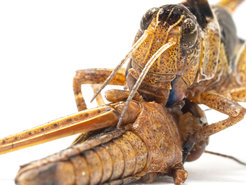Chemical signal protects migratory locusts from cannibalism
Migratory locusts release a toxic substance to fend off their own conspecifics
In a new study in the journal Science, researchers from the Max Planck Institute for Chemical Ecology, together with partners from China and the University of Halle, Germany, show that the migratory locust Locusta migratoria produces the compound phenylacetonitrile (PAN) to defend itself against feeding attacks by conspecifics as population density increases. Cannibalism rates increased in locusts that could no longer produce PAN. The researchers also identified the odor receptor for PAN in the locusts. They showed in animals with a PAN receptor that was no longer functional that it is necessary for the perception of PAN and the suppression of cannibalistic behavior. The discovery of an anti-cannibalism pheromone offers new approaches for locust control (Science, May 2023, DOI: 10.1126/science.ade6155).

Huge swarms of migratory locusts take on the proportions of natural disasters and threaten the food supply of millions of people, especially in Africa and Asia. As the eighth of the ten biblical plagues, the Book of Moses in the Old Testament already describes how swarms of locusts darkened the sky and ate up everything that grew in the fields and on the trees. Scientists suspect that cannibalism among locusts contributes to their swarming behavior, and swarms therefore constantly move on because individual animals are always on the run from conspecifics pursuing them. "We wondered how these insects influence each other's behavior within huge swarms, and whether olfaction plays a role. An important basis for us was the research on the formation of locust swarms by Iain Couzin of the Max Planck Institute for Behavioral Biology in Constance," says study leader Bill Hansson, director of the Department of Evolutionary Neuroethology at the Max Planck Institute, explaining the starting point of the study.
Migratory locusts occur in different phases: In the solitary phase, the insects live individually and stay in the area, while in the gregarious phase they exhibit the typical swarming behavior that fits their denomination as migratory locusts. "In most cases, locusts are in the solitary phase, where they avoid physical contact with conspecifics and eat comparatively little food. If the population density increases due to rainfall and sufficient food, the locusts change their behavior within a few hours; they can smell, see, and touch each other. These three types of stimulation increase serotonin and dopamine levels in the locust brain, causing solitary locusts to become aggressive gregarious locusts that are very active and have a large appetite. They also release aggregation pheromones, which eventually leads to swarming and poses a huge threat to agricultural production. Cannibalism does only occur in the gregarious phase," explains the study's first author Hetan Chang.
Behavioral experiments with the migratory locust Locusta migratoria showed that cannibalism rates increased with the number of gregarious animals that were kept together in a cage. Thus, there is a direct relationship between population density and cannibalistic behavior. To find out if gregarious locusts emit particular odors that are not produced in the solitary phase, the research team analyzed and compared all odors emitted by solitary and gregarious locust in the juvenile stage. Of the 17 odors produced exclusively in the gregarious phase, only phenylacetonitrile (PAN) turned out to be an odor signal that deterred other locusts in behavioral tests. For further confirmation of PAN's function, the scientists used genetically modified locusts that could no longer produce PAN. "We showed that as population density increased, not only did the level of cannibalism rise, but the animals also produced more PAN. Using genome editing, we were able to knock out an enzyme responsible for the production of this compound. This allowed us to confirm its strong anti-cannibalistic effect, because cannibalism was again significantly increased when the animals were no longer able to produce the compound," says Hetan Chang.
The biggest challenge was finding the olfactory receptor that recognizes PAN. Since locusts have more than 140 olfactory receptor genes, the research team had to clone as many genes as possible and test them one by one. Tests on 49 different olfactory receptors using more than 200 relevant odors eventually led to the identification of the olfactory receptor OR70a as a highly sensitive and specific detector of PAN in the migratory locust Locusta migratoria. Behavioral experiments with genetically modified locusts whose OR70a receptor was no longer functioning again showed a strongly increased cannibalism rate, which is due to the fact that the cannibalism stop signal can no longer be perceived by the locusts without the corresponding receptor.
A pheromone that controls cannibalism is an absolute new discovery. Because cannibalism has a major impact on locust swarm dynamics, a fundamental understanding of the population ecology of these animals, particularly the effect of PAN, opens up new possibilities of locust control. "If you inhibit the production of PAN or the function of the receptor, you could get the locusts to behave more cannibalistically and potentially control themselves in that way," Bill Hansson says.
